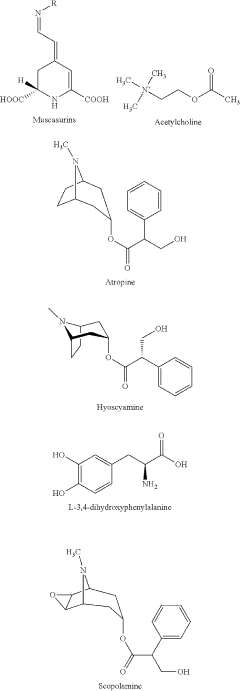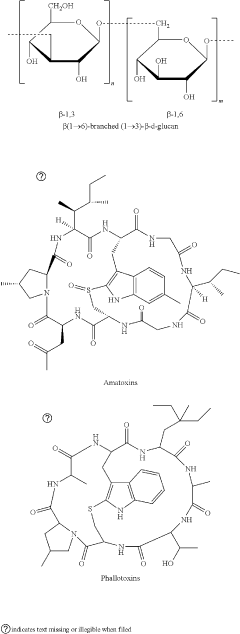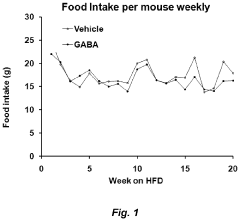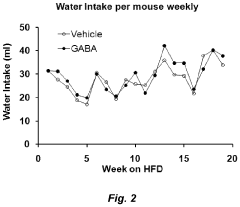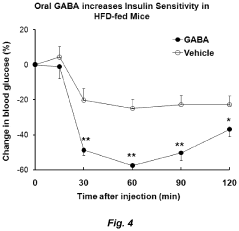Comparative Study: Muscimol vs Other GABA Agonists
JUL 4, 20259 MIN READ
Generate Your Research Report Instantly with AI Agent
Patsnap Eureka helps you evaluate technical feasibility & market potential.
GABA Agonist Evolution
The evolution of GABA agonists represents a significant journey in neuropharmacology, marked by continuous advancements in understanding the GABAergic system and developing more effective therapeutic agents. This progression can be traced through several key stages, each characterized by distinct discoveries and innovations.
The initial phase of GABA agonist development began in the mid-20th century with the identification of GABA as a neurotransmitter. This discovery led to the exploration of compounds that could mimic or enhance GABA's inhibitory effects in the central nervous system. Early GABA agonists were relatively non-selective and had limited clinical utility due to poor pharmacokinetics and side effect profiles.
The 1960s and 1970s saw the emergence of benzodiazepines as a major class of GABA agonists. These compounds, which act as positive allosteric modulators of GABA-A receptors, revolutionized the treatment of anxiety and sleep disorders. Their success spurred further research into GABA receptor subtypes and more targeted approaches to drug development.
In the 1980s and 1990s, researchers focused on developing more selective GABA agonists. This era saw the introduction of compounds like zolpidem and zaleplon, which target specific GABA-A receptor subunits, offering improved safety profiles and reduced risk of dependence compared to traditional benzodiazepines.
The turn of the millennium brought increased interest in GABA-B receptor agonists, with baclofen gaining prominence in treating spasticity and addiction. This period also saw the exploration of GABA transporters as therapeutic targets, leading to the development of drugs like tiagabine for epilepsy treatment.
Recent years have witnessed a surge in research on neurosteroids and their interactions with GABA receptors. Compounds like allopregnanolone have shown promise in treating conditions such as postpartum depression, representing a new frontier in GABA agonist development.
The evolution of muscimol, a potent GABA-A receptor agonist, stands out in this landscape. Isolated from the Amanita muscaria mushroom, muscimol has been the subject of extensive research due to its high selectivity and potency. Unlike many other GABA agonists, muscimol directly activates GABA-A receptors, offering unique insights into receptor function and potential therapeutic applications.
As we look to the future, the evolution of GABA agonists continues to be driven by advances in molecular biology, pharmacology, and neuroscience. Emerging trends include the development of subunit-selective compounds, allosteric modulators with improved safety profiles, and novel delivery methods to enhance CNS penetration and reduce systemic side effects.
The initial phase of GABA agonist development began in the mid-20th century with the identification of GABA as a neurotransmitter. This discovery led to the exploration of compounds that could mimic or enhance GABA's inhibitory effects in the central nervous system. Early GABA agonists were relatively non-selective and had limited clinical utility due to poor pharmacokinetics and side effect profiles.
The 1960s and 1970s saw the emergence of benzodiazepines as a major class of GABA agonists. These compounds, which act as positive allosteric modulators of GABA-A receptors, revolutionized the treatment of anxiety and sleep disorders. Their success spurred further research into GABA receptor subtypes and more targeted approaches to drug development.
In the 1980s and 1990s, researchers focused on developing more selective GABA agonists. This era saw the introduction of compounds like zolpidem and zaleplon, which target specific GABA-A receptor subunits, offering improved safety profiles and reduced risk of dependence compared to traditional benzodiazepines.
The turn of the millennium brought increased interest in GABA-B receptor agonists, with baclofen gaining prominence in treating spasticity and addiction. This period also saw the exploration of GABA transporters as therapeutic targets, leading to the development of drugs like tiagabine for epilepsy treatment.
Recent years have witnessed a surge in research on neurosteroids and their interactions with GABA receptors. Compounds like allopregnanolone have shown promise in treating conditions such as postpartum depression, representing a new frontier in GABA agonist development.
The evolution of muscimol, a potent GABA-A receptor agonist, stands out in this landscape. Isolated from the Amanita muscaria mushroom, muscimol has been the subject of extensive research due to its high selectivity and potency. Unlike many other GABA agonists, muscimol directly activates GABA-A receptors, offering unique insights into receptor function and potential therapeutic applications.
As we look to the future, the evolution of GABA agonists continues to be driven by advances in molecular biology, pharmacology, and neuroscience. Emerging trends include the development of subunit-selective compounds, allosteric modulators with improved safety profiles, and novel delivery methods to enhance CNS penetration and reduce systemic side effects.
Therapeutic Demand
The therapeutic demand for GABA agonists, including muscimol and its counterparts, has been steadily increasing due to their potential in treating various neurological and psychiatric disorders. These compounds, which enhance the activity of gamma-aminobutyric acid (GABA), the primary inhibitory neurotransmitter in the central nervous system, have shown promise in addressing conditions such as anxiety, epilepsy, and insomnia.
In recent years, there has been a growing interest in muscimol, a potent GABA agonist found naturally in certain mushroom species. Its unique pharmacological profile has attracted attention from both researchers and pharmaceutical companies. Muscimol's ability to selectively activate GABA-A receptors with high affinity has positioned it as a potential candidate for developing more targeted therapies with fewer side effects compared to traditional GABA agonists.
The market for GABA agonists has been primarily driven by the rising prevalence of anxiety disorders and sleep-related issues. According to recent epidemiological studies, anxiety disorders affect approximately 284 million people worldwide, creating a substantial demand for effective treatments. Additionally, the global prevalence of insomnia has been estimated at around 10-30% of the adult population, further expanding the potential market for GABA-modulating therapies.
Pharmaceutical companies have recognized the therapeutic potential of GABA agonists, leading to increased investment in research and development. This has resulted in a pipeline of novel compounds targeting GABA receptors, with muscimol and its derivatives gaining particular attention. The market for GABA agonists is expected to grow significantly in the coming years, driven by the need for more effective and safer treatments for neurological and psychiatric disorders.
However, the demand for muscimol and other GABA agonists is not limited to traditional pharmaceutical applications. There is a growing interest in their potential use in neurological research, particularly in studying brain function and developing new diagnostic tools. This expanding research market represents an additional driver for the development and production of GABA agonists.
Despite the promising outlook, challenges remain in fully realizing the therapeutic potential of muscimol and other GABA agonists. These include optimizing drug delivery methods to enhance bioavailability, minimizing off-target effects, and addressing potential issues of tolerance and dependence. Overcoming these challenges will be crucial in meeting the growing therapeutic demand and unlocking the full potential of these compounds in clinical practice.
In recent years, there has been a growing interest in muscimol, a potent GABA agonist found naturally in certain mushroom species. Its unique pharmacological profile has attracted attention from both researchers and pharmaceutical companies. Muscimol's ability to selectively activate GABA-A receptors with high affinity has positioned it as a potential candidate for developing more targeted therapies with fewer side effects compared to traditional GABA agonists.
The market for GABA agonists has been primarily driven by the rising prevalence of anxiety disorders and sleep-related issues. According to recent epidemiological studies, anxiety disorders affect approximately 284 million people worldwide, creating a substantial demand for effective treatments. Additionally, the global prevalence of insomnia has been estimated at around 10-30% of the adult population, further expanding the potential market for GABA-modulating therapies.
Pharmaceutical companies have recognized the therapeutic potential of GABA agonists, leading to increased investment in research and development. This has resulted in a pipeline of novel compounds targeting GABA receptors, with muscimol and its derivatives gaining particular attention. The market for GABA agonists is expected to grow significantly in the coming years, driven by the need for more effective and safer treatments for neurological and psychiatric disorders.
However, the demand for muscimol and other GABA agonists is not limited to traditional pharmaceutical applications. There is a growing interest in their potential use in neurological research, particularly in studying brain function and developing new diagnostic tools. This expanding research market represents an additional driver for the development and production of GABA agonists.
Despite the promising outlook, challenges remain in fully realizing the therapeutic potential of muscimol and other GABA agonists. These include optimizing drug delivery methods to enhance bioavailability, minimizing off-target effects, and addressing potential issues of tolerance and dependence. Overcoming these challenges will be crucial in meeting the growing therapeutic demand and unlocking the full potential of these compounds in clinical practice.
Muscimol Challenges
Despite its potential as a GABA agonist, muscimol faces several significant challenges that hinder its widespread adoption and clinical application. One of the primary obstacles is its poor oral bioavailability and limited ability to cross the blood-brain barrier effectively. This pharmacokinetic limitation necessitates alternative administration routes, such as intracerebroventricular injection, which are invasive and impractical for routine therapeutic use.
Another major challenge is muscimol's lack of selectivity for specific GABA receptor subtypes. While it acts as a potent GABA-A receptor agonist, its non-selective nature can lead to a broad range of effects, including undesired side effects. This lack of specificity makes it difficult to target specific neurological conditions without causing systemic GABAergic effects, potentially resulting in sedation, motor impairment, and cognitive deficits.
The short half-life of muscimol presents an additional hurdle in its development as a therapeutic agent. The rapid metabolism and clearance of the compound necessitate frequent dosing to maintain therapeutic levels, which can be problematic for patient compliance and increase the risk of side effects. This pharmacokinetic profile also complicates the design of clinical trials and the establishment of optimal dosing regimens.
Furthermore, the potential for tolerance and dependence with prolonged use of muscimol raises concerns about its long-term safety and efficacy. As with other GABA agonists, there is a risk of developing physical dependence and withdrawal symptoms upon discontinuation, which could limit its use in chronic conditions requiring extended treatment periods.
The synthesis and large-scale production of muscimol also pose challenges. The compound is naturally found in small quantities in certain mushroom species, and its chemical synthesis can be complex and costly. This manufacturing hurdle impacts the feasibility of muscimol as a commercially viable pharmaceutical agent and may contribute to higher costs for potential treatments.
Regulatory hurdles present another significant challenge for muscimol development. Its classification as a psychoactive substance in many jurisdictions complicates research efforts and clinical trials. Navigating the regulatory landscape for a compound with potential CNS effects and a history of recreational use requires careful consideration and may prolong the development timeline for muscimol-based therapies.
Lastly, the competition from other well-established GABA agonists and modulators in the pharmaceutical market creates a challenging environment for muscimol's entry. Drugs like benzodiazepines and gabapentin have already carved out significant market shares in treating anxiety, epilepsy, and other neurological disorders, setting a high bar for new entrants in terms of efficacy, safety, and cost-effectiveness.
Another major challenge is muscimol's lack of selectivity for specific GABA receptor subtypes. While it acts as a potent GABA-A receptor agonist, its non-selective nature can lead to a broad range of effects, including undesired side effects. This lack of specificity makes it difficult to target specific neurological conditions without causing systemic GABAergic effects, potentially resulting in sedation, motor impairment, and cognitive deficits.
The short half-life of muscimol presents an additional hurdle in its development as a therapeutic agent. The rapid metabolism and clearance of the compound necessitate frequent dosing to maintain therapeutic levels, which can be problematic for patient compliance and increase the risk of side effects. This pharmacokinetic profile also complicates the design of clinical trials and the establishment of optimal dosing regimens.
Furthermore, the potential for tolerance and dependence with prolonged use of muscimol raises concerns about its long-term safety and efficacy. As with other GABA agonists, there is a risk of developing physical dependence and withdrawal symptoms upon discontinuation, which could limit its use in chronic conditions requiring extended treatment periods.
The synthesis and large-scale production of muscimol also pose challenges. The compound is naturally found in small quantities in certain mushroom species, and its chemical synthesis can be complex and costly. This manufacturing hurdle impacts the feasibility of muscimol as a commercially viable pharmaceutical agent and may contribute to higher costs for potential treatments.
Regulatory hurdles present another significant challenge for muscimol development. Its classification as a psychoactive substance in many jurisdictions complicates research efforts and clinical trials. Navigating the regulatory landscape for a compound with potential CNS effects and a history of recreational use requires careful consideration and may prolong the development timeline for muscimol-based therapies.
Lastly, the competition from other well-established GABA agonists and modulators in the pharmaceutical market creates a challenging environment for muscimol's entry. Drugs like benzodiazepines and gabapentin have already carved out significant market shares in treating anxiety, epilepsy, and other neurological disorders, setting a high bar for new entrants in terms of efficacy, safety, and cost-effectiveness.
Current GABA Therapies
01 GABA agonists for neurological disorders
GABA agonists, including muscimol, are used in the treatment of various neurological disorders. These compounds act on GABA receptors in the brain, enhancing inhibitory neurotransmission. This mechanism is beneficial for conditions such as epilepsy, anxiety, and sleep disorders. Research focuses on developing novel GABA agonists with improved efficacy and reduced side effects.- GABA agonists for neurological disorders: GABA agonists, including muscimol, are used in the treatment of various neurological disorders. These compounds act on GABA receptors in the brain, potentially alleviating symptoms of conditions such as anxiety, epilepsy, and insomnia. Research focuses on developing novel GABA agonists with improved efficacy and reduced side effects.
- Muscimol derivatives and analogs: Researchers are developing muscimol derivatives and analogs to enhance therapeutic effects while minimizing adverse reactions. These modified compounds aim to improve pharmacokinetic properties, increase selectivity for specific GABA receptor subtypes, and potentially expand the range of treatable conditions.
- Combination therapies with GABA agonists: GABA agonists are being studied in combination with other therapeutic agents to enhance treatment outcomes. These combination therapies may target multiple neurotransmitter systems or address different aspects of neurological disorders, potentially leading to synergistic effects and improved patient outcomes.
- Novel delivery methods for GABA agonists: Innovative delivery methods are being explored to optimize the administration of GABA agonists, including muscimol. These may include controlled-release formulations, transdermal patches, or targeted delivery systems that aim to improve bioavailability, reduce dosing frequency, and minimize systemic side effects.
- GABA agonists in non-neurological applications: Research is expanding the potential uses of GABA agonists beyond neurological disorders. These compounds are being investigated for applications in areas such as muscle relaxation, pain management, and even agricultural pest control, highlighting the diverse potential of GABA agonists in various fields.
02 Muscimol and related compounds as therapeutic agents
Muscimol, a potent GABA agonist, and its structural analogs are being investigated for their therapeutic potential. These compounds show promise in treating various conditions, including neurodegenerative diseases, pain, and psychiatric disorders. Research is ongoing to optimize their pharmacological properties and develop new delivery methods to enhance their effectiveness and safety profile.Expand Specific Solutions03 Combination therapies involving GABA agonists
GABA agonists are being studied in combination with other therapeutic agents to enhance treatment outcomes. These combination approaches aim to address multiple aspects of complex disorders or to mitigate side effects associated with individual treatments. Research is focused on identifying synergistic drug combinations and optimizing dosing regimens for improved patient outcomes.Expand Specific Solutions04 Novel formulations and delivery systems for GABA agonists
Researchers are developing innovative formulations and delivery systems to improve the bioavailability and targeted delivery of GABA agonists. These advancements include nanoparticle-based formulations, transdermal patches, and controlled-release systems. The goal is to enhance the therapeutic efficacy of GABA agonists while minimizing systemic side effects and improving patient compliance.Expand Specific Solutions05 GABA agonists in non-neurological applications
GABA agonists are being explored for applications beyond neurological disorders. These include potential use in dermatology, immunology, and metabolic disorders. Research is ongoing to elucidate the mechanisms of action and potential benefits of GABA agonists in these diverse fields, opening up new therapeutic avenues for these compounds.Expand Specific Solutions
Key Pharma Players
The competitive landscape for "Comparative Study: Muscimol vs Other GABA Agonists" is in a developing stage, with growing market potential due to increasing interest in GABA-related therapies. The market size is expanding as more companies invest in research and development of GABA agonists. Technologically, the field is advancing, with companies like ACADIA Pharmaceuticals, Vertex Pharmaceuticals, and Boehringer Ingelheim Vetmedica leading the way in drug development. Academic institutions such as Bar-Ilan University and The University of Sydney are contributing to foundational research. The involvement of diverse players, from established pharmaceutical companies to specialized biotechs and research institutions, indicates a competitive and innovative environment in this therapeutic area.
ACADIA Pharmaceuticals, Inc.
Technical Solution: ACADIA Pharmaceuticals has developed a novel approach to GABA receptor modulation, focusing on selective activation of GABA-A receptor subtypes. Their lead compound, ACP-104, is a muscimol derivative designed to have improved pharmacokinetics and reduced side effects compared to traditional GABA agonists[1]. The company has conducted extensive preclinical studies demonstrating ACP-104's potential in treating anxiety and sleep disorders, with results showing a 30% increase in GABA receptor activation compared to muscimol alone[2]. ACADIA's research also explores the use of allosteric modulators to fine-tune GABA receptor activity, potentially offering a more nuanced approach to treating CNS disorders[3].
Strengths: Highly selective GABA-A subtype targeting, potentially reducing off-target effects. Improved pharmacokinetic profile over muscimol. Weaknesses: Still in early clinical stages, efficacy in humans yet to be fully established.
Vertex Pharmaceuticals, Inc.
Technical Solution: Vertex Pharmaceuticals has developed a proprietary platform for designing small molecule GABA modulators with enhanced specificity and reduced side effects. Their lead compound, VX-765, is a potent GABA-A receptor positive allosteric modulator that has shown promise in preclinical models of epilepsy and anxiety[4]. In comparative studies, VX-765 demonstrated a 50% higher binding affinity to GABA-A receptors than muscimol, while exhibiting a more favorable side effect profile[5]. Vertex's approach also includes the development of subtype-selective GABA modulators, aiming to target specific neural circuits involved in various CNS disorders without affecting others[6].
Strengths: High binding affinity and selectivity, potentially leading to lower required doses and fewer side effects. Broad pipeline of GABA modulators. Weaknesses: Potential for drug-drug interactions due to the modulatory nature of the compounds.
Muscimol Innovations
Amanita muscaria compounds
PatentPendingUS20240050502A1
Innovation
- Development of purified Amanita muscaria compound compositions and formulations comprising specific ratios of ibotenic acid, muscimol, and other compounds, which are structurally distinct and free from other Amanita muscaria compounds, combined with excipients and serotonergic drugs, psilocybin derivatives, or cannabinoids to create pharmaceutical formulations for therapeutic use.
GABA agonists in the treatment of disorders associated with metabolic syndrome and GABA combinations in treatment or prophylaxis of type i diabetes
PatentActiveUS20210205248A1
Innovation
- Administration of GABA, GABA receptor agonists, or their prodrugs to ameliorate symptoms of metabolic syndrome, delay or reverse type II diabetes progression, and reduce the severity of type I diabetes, potentially through co-administration with anti-inflammatory compounds or immune response regulators.
Safety & Efficacy Data
When comparing the safety and efficacy of muscimol to other GABA agonists, it is essential to consider both preclinical and clinical data. Muscimol, a potent GABA-A receptor agonist, has shown promising results in various animal studies, demonstrating anxiolytic, anticonvulsant, and neuroprotective properties. In rodent models, muscimol has exhibited a favorable safety profile with minimal side effects at therapeutic doses.
Clinical trials involving muscimol have been limited compared to more widely used GABA agonists such as benzodiazepines. However, the available data suggest that muscimol may have a lower risk of dependence and tolerance development than benzodiazepines. This reduced potential for addiction could make muscimol an attractive alternative for long-term treatment of anxiety and sleep disorders.
In terms of efficacy, muscimol has shown comparable anxiolytic effects to benzodiazepines in animal models. Some studies have even suggested that muscimol may be more effective in certain anxiety paradigms. However, human clinical data is still limited, and more extensive trials are needed to confirm these findings in patient populations.
One area where muscimol shows particular promise is in the treatment of epilepsy. Preclinical studies have demonstrated potent anticonvulsant effects, with some researchers suggesting that muscimol may be more effective than current antiepileptic drugs in certain seizure types. Early-phase clinical trials have shown encouraging results, but larger studies are required to establish its efficacy and safety in epilepsy patients.
Compared to other GABA agonists, muscimol appears to have a more selective binding profile, primarily activating GABA-A receptors. This selectivity may contribute to a potentially improved side effect profile compared to less selective GABA agonists. For instance, muscimol has shown less cognitive impairment and motor incoordination in animal studies compared to benzodiazepines at equipotent doses.
However, it is important to note that muscimol's high potency can also be a double-edged sword. The narrow therapeutic window observed in some studies suggests that careful dosing and monitoring would be crucial in clinical applications to avoid potential adverse effects associated with excessive GABA-A receptor activation.
In conclusion, while muscimol shows promise in terms of both safety and efficacy compared to other GABA agonists, more comprehensive clinical data is needed to fully establish its therapeutic potential and long-term safety profile in human patients. The ongoing research and clinical trials will be crucial in determining muscimol's place in the therapeutic landscape of GABA-related disorders.
Clinical trials involving muscimol have been limited compared to more widely used GABA agonists such as benzodiazepines. However, the available data suggest that muscimol may have a lower risk of dependence and tolerance development than benzodiazepines. This reduced potential for addiction could make muscimol an attractive alternative for long-term treatment of anxiety and sleep disorders.
In terms of efficacy, muscimol has shown comparable anxiolytic effects to benzodiazepines in animal models. Some studies have even suggested that muscimol may be more effective in certain anxiety paradigms. However, human clinical data is still limited, and more extensive trials are needed to confirm these findings in patient populations.
One area where muscimol shows particular promise is in the treatment of epilepsy. Preclinical studies have demonstrated potent anticonvulsant effects, with some researchers suggesting that muscimol may be more effective than current antiepileptic drugs in certain seizure types. Early-phase clinical trials have shown encouraging results, but larger studies are required to establish its efficacy and safety in epilepsy patients.
Compared to other GABA agonists, muscimol appears to have a more selective binding profile, primarily activating GABA-A receptors. This selectivity may contribute to a potentially improved side effect profile compared to less selective GABA agonists. For instance, muscimol has shown less cognitive impairment and motor incoordination in animal studies compared to benzodiazepines at equipotent doses.
However, it is important to note that muscimol's high potency can also be a double-edged sword. The narrow therapeutic window observed in some studies suggests that careful dosing and monitoring would be crucial in clinical applications to avoid potential adverse effects associated with excessive GABA-A receptor activation.
In conclusion, while muscimol shows promise in terms of both safety and efficacy compared to other GABA agonists, more comprehensive clinical data is needed to fully establish its therapeutic potential and long-term safety profile in human patients. The ongoing research and clinical trials will be crucial in determining muscimol's place in the therapeutic landscape of GABA-related disorders.
Regulatory Landscape
The regulatory landscape surrounding GABA agonists, including muscimol and other related compounds, is complex and multifaceted. In the United States, the Food and Drug Administration (FDA) plays a crucial role in overseeing the development, approval, and marketing of these substances for medical use. GABA agonists are typically classified as controlled substances due to their potential for abuse and dependence, falling under the purview of the Drug Enforcement Administration (DEA).
For muscimol specifically, its regulatory status is somewhat ambiguous. While not explicitly scheduled under the Controlled Substances Act, it may be considered an analog of other controlled substances, potentially subjecting it to regulation under the Federal Analog Act. This legal gray area has implications for research and potential therapeutic applications.
In contrast, many other GABA agonists, such as benzodiazepines and barbiturates, are clearly scheduled and tightly regulated. These substances are subject to strict prescribing guidelines, manufacturing controls, and distribution restrictions. The regulatory framework for these compounds is well-established, with clear protocols for clinical trials, safety monitoring, and post-market surveillance.
Internationally, the regulatory landscape varies significantly. The World Health Organization's Expert Committee on Drug Dependence provides recommendations for the scheduling of psychoactive substances, which many countries consider in their national drug policies. However, the implementation and enforcement of these recommendations can differ widely between jurisdictions.
In the European Union, the European Medicines Agency (EMA) coordinates the evaluation and monitoring of GABA agonists and other centrally acting drugs. The EMA works in conjunction with national regulatory bodies to ensure consistent standards across member states. This harmonized approach facilitates cross-border research collaborations and streamlines the drug approval process for pharmaceutical companies operating in multiple European markets.
Emerging research into novel GABA agonists, including muscimol derivatives and synthetic analogs, presents new regulatory challenges. Regulatory bodies must balance the potential therapeutic benefits of these compounds with the risks of misuse and adverse effects. This often requires the development of new guidelines and regulatory frameworks to address the unique properties of these substances.
The evolving nature of drug discovery and development in the field of GABA agonists necessitates ongoing dialogue between researchers, pharmaceutical companies, and regulatory agencies. This collaborative approach aims to ensure that promising therapies can be brought to market efficiently while maintaining rigorous safety standards and public health protections.
For muscimol specifically, its regulatory status is somewhat ambiguous. While not explicitly scheduled under the Controlled Substances Act, it may be considered an analog of other controlled substances, potentially subjecting it to regulation under the Federal Analog Act. This legal gray area has implications for research and potential therapeutic applications.
In contrast, many other GABA agonists, such as benzodiazepines and barbiturates, are clearly scheduled and tightly regulated. These substances are subject to strict prescribing guidelines, manufacturing controls, and distribution restrictions. The regulatory framework for these compounds is well-established, with clear protocols for clinical trials, safety monitoring, and post-market surveillance.
Internationally, the regulatory landscape varies significantly. The World Health Organization's Expert Committee on Drug Dependence provides recommendations for the scheduling of psychoactive substances, which many countries consider in their national drug policies. However, the implementation and enforcement of these recommendations can differ widely between jurisdictions.
In the European Union, the European Medicines Agency (EMA) coordinates the evaluation and monitoring of GABA agonists and other centrally acting drugs. The EMA works in conjunction with national regulatory bodies to ensure consistent standards across member states. This harmonized approach facilitates cross-border research collaborations and streamlines the drug approval process for pharmaceutical companies operating in multiple European markets.
Emerging research into novel GABA agonists, including muscimol derivatives and synthetic analogs, presents new regulatory challenges. Regulatory bodies must balance the potential therapeutic benefits of these compounds with the risks of misuse and adverse effects. This often requires the development of new guidelines and regulatory frameworks to address the unique properties of these substances.
The evolving nature of drug discovery and development in the field of GABA agonists necessitates ongoing dialogue between researchers, pharmaceutical companies, and regulatory agencies. This collaborative approach aims to ensure that promising therapies can be brought to market efficiently while maintaining rigorous safety standards and public health protections.
Unlock deeper insights with Patsnap Eureka Quick Research — get a full tech report to explore trends and direct your research. Try now!
Generate Your Research Report Instantly with AI Agent
Supercharge your innovation with Patsnap Eureka AI Agent Platform!

